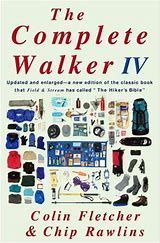Keep Calm and Read On: In the Beginning
By Wayne Limberg

Many thanks to PATC member Barry Chafin for recommending Colin Fletcher's "The Complete Walker." Three more editions followed in 1974, 1984, and 2002. All were bestsellers. I had considered reviewing the book for some time but had hesitated, fearing that even the totally revamped 2002 edition would seem outdated. Barry's email led me to take another look. Like him, I was surprised by how well the book holds up. As Barry said in his email, “The value of the book is there for anyone to see. This is more than ‘a how-to’ book. It is literature." Amen.
Colin Fletcher was born in Cardiff, Wales and educated in England. He served in the Royal Marine Commandos during and after World War II. After the war he spent a decade farming in Kenya and prospecting in Canada, before moving to the U.S. in 1956. In 1958, he walked the entire eastern edge of California, 35 years before the completion of the PCT, a journey he recounted in his first book, "The Thousand-Mile Summer,” published in 1964. Four years later saw the release of the first edition of "The Complete Walker" and "The Man Who Walked Through Time," an account of his continuous hike through Grand Canyon National Park, a first. In the decade before his death in 2007, Fletcher focused on environmental issues. In all, he wrote 10 books, including “River: One Man's Journey Down the Colorado.”
As with
most of his books it was a metaphor,
comparing the journey of the river to the sea to life itself. Fletcher once described himself as someone "who valued solitude and silence and square, smoothed-off granite boulders."
"The Complete Walker" was Fletcher's most popular book and established his reputation as the "spiritual godfather" of modern wilderness backpacking and even has been credited as an impetus for the modern backpacking industry. When the book appeared in 1968, backpacking was relatively young and mostly done as part of a hunting or fishing trip or a Scout outing, not as a pursuit in itself. Much of the equipment was military surplus or homemade. Ed Shaffer used his old army rucksack and pith helmet on his first AT thru-hike. Grandma Gatewood hiked in Converse high-tops and a London Fog raincoat. REI had one store. Backpacker magazine and Patagonia were only a year old. Vibram-soled waffle stompers and Kelty external pack frames were cutting edge. I had hair.
The ”Complete Walker” was not the first book about hiking and backpacking. Few if any, however, were comprehensive how-to books on the scale of "The Complete Walker." In the book, Fletcher builds "a house on your back" to address what any backpacker required. Each chapter of the book dealt in detail with a room in that house. "Foundations," for example, looked at footwear, “Walls" at packs, whereas “Kitchens” covered stoves and cookware. Included were detailed pen and ink drawings of chosen gear. Unlike more recent reviews, cost was a consideration; simplest and cheapest often came out on top.
Each chapter ended with advice on how to best use the gear with examples from Fletcher’s own experiences. These passages often revealed his sense of humor and eccentricities. Although he gave a nod to ultra-lite gear in the final edition of "The Complete Walker," he was not inclined to sacrifice comfort for a few saved ounces. His personal choice in pants remained wide-wale corduroy shorts. Weather permitting, he preferred to sleep under the stars, and as he bedded down, he arranged his gear so he could have breakfast without getting out of his sleeping bag. He usually had his main meal midday—with tea, not coffee. Though he never directly addresses it, he probably had little patience for record setting. The book is titled "The Complete Walker," not "Racer." His favorite paces were "slow and slower."
Although each edition of "The Complete Walker" changed to keep up with technology, core ideas remained. This was no accident. Fletcher's choice of the title "The Complete Walker" was a nod to Izaak Walton's 17th century classic "The Compleat Angler." Both books deal with themes that have stood the test of time. Both read fresh despite changes in gear and culture—and Walton's somewhat archaic prose. Both have what can only be called a spiritual quality. Small wonder that "The Complete Walker" helped more than one Vietnam vet in the 1970s find peace and can rightfully claim a place next to the works of Thoreau, Muir, and Leopold.
At the end of "The Complete Walker" are several useful, if somewhat dated appendices. One is a basic checklist of equipment, another provides more focused lists on what to bring on different types of hike—a one day in-and-out, a quick overnighter, and a five-or-more day. Yet another is basically a reading list in the form of a bibliography. The last—and best—is a collection of quotes on walking ranging from Emerson to Frank Herbert. At first glance it is simply a compilation of quotes, but a closer read reveals it is a sly and often humorous debate. To that end, it is probably best to end as “The Complete Walker" does:
"And so you find that you can take up once more the struggle we all have to make in our own several and quirky ways if we are to succeed in living lives that are truly human—the struggle to discern some glimmering of sense in the extraordinary phenomenon that is man. And that, I guess, is quite a lot to get out of such a simple thing as walking.”
Have a good read? Send it along to wplimberg@aol.com. See you on the trail.
